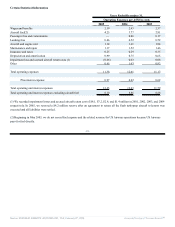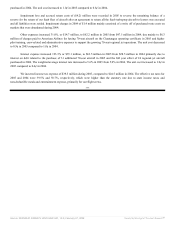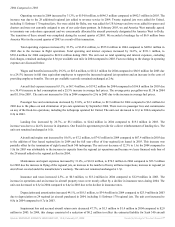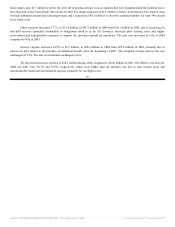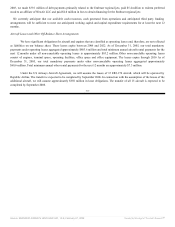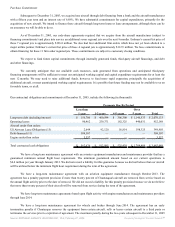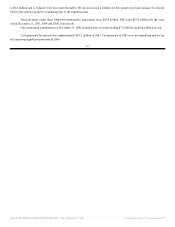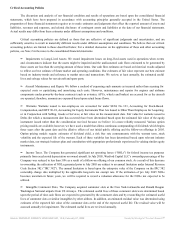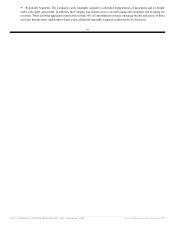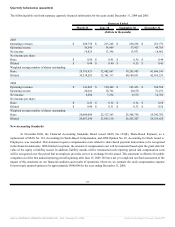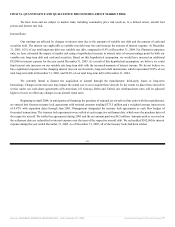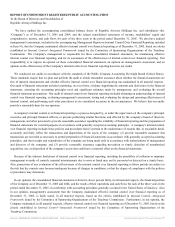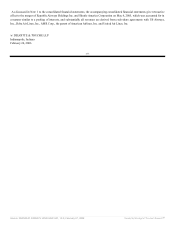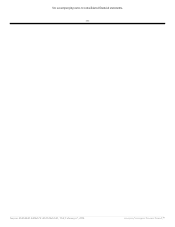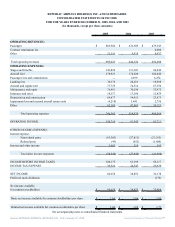Frontier Airlines 2005 Annual Report Download - page 71
Download and view the complete annual report
Please find page 71 of the 2005 Frontier Airlines annual report below. You can navigate through the pages in the report by either clicking on the pages listed below, or by using the keyword search tool below to find specific information within the annual report.
Critical Accounting Policies
The discussion and analysis of our financial condition and results of operations are based upon the consolidated financial
statements, which have been prepared in accordance with accounting principles generally accepted in the United States. The
preparation of these financial statements requires us to make estimates and judgments that affect the reported amount of assets and
liabilities, revenues and expenses, and related disclosure of contingent assets and liabilities at the date of our financial statements.
Actual results may differ from these estimates under different assumptions and conditions.
Critical accounting policies are defined as those that are reflective of significant judgments and uncertainties, and are
sufficiently sensitive to result in materially different results under different assumptions and conditions. We believe that our critical
accounting policies are limited to those described below. For a detailed discussion on the application of these and other accounting
policies, see Note 2 in the notes to the consolidated financial statements.
Impairments to Long-Lived Assets. We record impairment losses on long-lived assets used in operations when events
and circumstances indicate that the assets might be impaired and the undiscounted cash flows estimated to be generated by
those assets are less than the carrying amount of those items. Our cash flow estimates are based on historical results adjusted
to reflect our best estimate of future market and operating conditions. Our estimates of fair value represent our best estimate
based on industry trends and reference to market rates and transactions. We review, at least annually, the estimated useful
lives and salvage values for our aircraft and spare parts.
Aircraft Maintenance and Repair. We follow a method of expensing such amounts as incurred rather than accruing for
expected costs or capitalizing and amortizing such costs. However, maintenance and repairs for engines and airframe
components under power-by-the-hour contracts (such as avionics, APUs, wheels and brakes) are accrued for as the aircraft
are operated; therefore, amounts are expensed based upon actual hours flown.
Warrants. Warrants issued to non-employees are accounted for under SFAS No. 123, Accounting for Stock-Based
Compensation, and EITF 96-18, Accounting for Equity Instruments That Are Issued to Other Than Employees for Acquiring,
or in Conjunction with Selling, Goods or Services, at fair value on the measurement date. Fair value for warrants issued to
Delta (for which a measurement date has occurred) have been determined based upon the estimated fair value of the equity
instrument issued rather than the consideration received because we believe it is more reliably measured. Various option
pricing models are available; however, we have used a model that allows continuous compounding of dividends which begins
three years after the grant date and the dilutive effects of our initial public offering and the follow-on offerings in 2005.
Option pricing models require estimates of dividend yield, a risk free rate commensurate with the warrant term, stock
volatility and the expected life of the warrant. Each of these variables has been determined based upon relevant industry
market data, our strategic business plan and consultation with appropriate professionals experienced in valuing similar equity
instruments.
Income Taxes. The Company has generated significant net operating losses (“NOLs”) for federal income tax purposes
primarily from accelerated depreciation on owned aircraft. In July 2005, Wexford Capital LLC’s ownership percentage of the
Company was reduced to less than 50% as a result of a follow-on offering of our common stock. As a result of this decrease
in ownership, the utilization of NOLs generated prior to July 2005 are subject to an annual limitation under Internal Revenue
Code Section 382 (“IRC 382”). The annual limitation is based upon the enterprise value of the Company on the IRC 382
ownership change date multiplied by the applicable long-term tax exempt rate. If the utilization of pre July 2005 NOLs
becomes uncertain in future years, we will be required to record a valuation allowance for the NOLs not expected to be
utilized.
Intangible Commuter Slots. The Company acquired commuter slots at the New York-LaGuardia and Ronald Reagan
Washington National airports from US Airways. The estimated useful lives of these commuter slots were determined based
upon the period of time cash flows are expected to generated by the commuter slots and by researching the estimated useful
lives of commuter slots or similar intangibles by other airlines. In addition, an estimated residual value was determined using
estimates of the expected fair value of the commuter slots at the end of the expected useful life. The residual value will be
assessed annually for impairment. The estimated useful lives are reviewed annually.
Source: REPUBLIC AIRWAYS HOLDINGS INC, 10-K, February 27, 2006 Powered by Morningstar® Document Research℠


